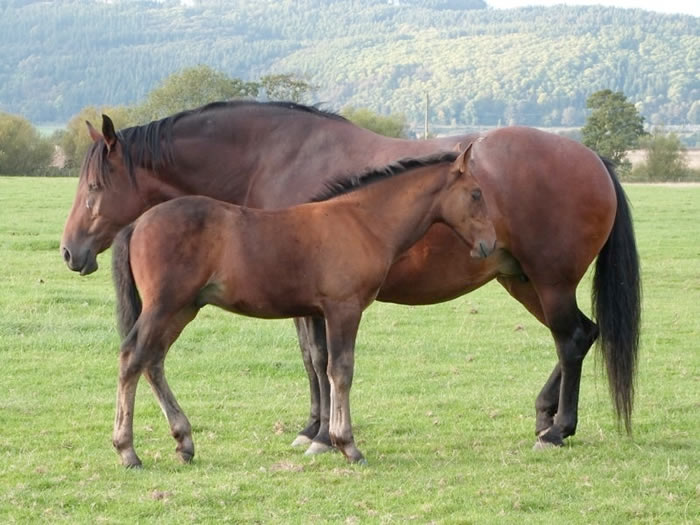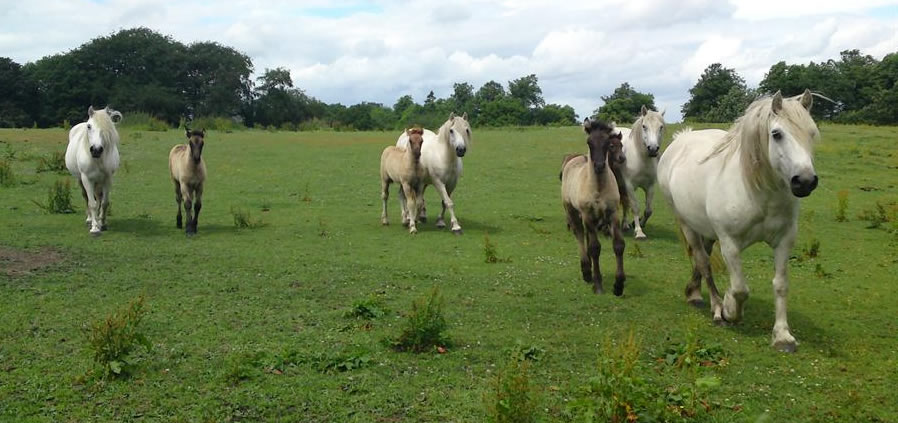Equine Showcase
Once again the Festival will be showcasing our equine heritage. Many folk getting into smallholding (and many existing smallholders) enjoy having an equine or two around the place – and they can do a job of work too.
For 2025, the Festival aims to showcase as many of our native equine breeds as possible.
Equine Parade
The equine parade will be in the main ring at 10am and 2.30pm
Clydesdale Horse
The Clydesdale breed was founded in the early eighteenth century when two breeders, John Paterson of Lochlyoch and the 6th Duke of Hamilton, imported Flemish stallions and mated them with native draught mares in the Clyde valley.
At its peak, Scotland had around 140,000 farm horses plus an unknown number in towns and cities, most of which were Clydesdales in whole or part. Clydesdales were also exported to many countries. As with other draught breeds, numbers dwindled with the increased use of mechanical power.
Clydesdales were bred for use as draught horses and are used in agriculture and logging as well as driving. Howver, thir popularity as ridden horses is increasing and they are now often shown under saddle.
The Clydesdale Horse is listed as At Risk by the RBST.
Shetland Pony
Today, the Shetland pony is used mainly for riding, driving and showing but the characteristics of strength, intelligence and docility make it entirely suitable as a working pony on today’s crofts and smallholdings.
Cleveland Bay
The Cleveland Bay is one of the rarest of the British equine breeds and is listed as “Priority” on the RBST Watchlist. The breed dates back to the 14th Century, where it was developed as a packhorse for the travelling salesman or Chapman – and the horses were known as Chapman horses. Later, in the 17th Century, the breed evolved into the superior carriage horse for which Yorkshire was famed. The breed was particularly badly hit by WW1, when it was used as to draw light artillery and as officers’ horses.

The coming of mechanization almost finished the breed off but in 1961, HM The Queen purchased one of the last great stallions, Mulgrave Supreme, and made him available for public stud. The Cleveland Bay is now popular as a riding and driving horse and for crossbreeding with the Thoroughbred to produce quality hunters. Cleveland Bays and their crosses can be found performing successfully in almost all equestrian disciplines.
The Cleveland Bays at the Festival are from John and Eva Bennett’s Brackenbrae Stud.
Highland Pony
Hard to believe that this breed is on the RBST Watchlist as At Risk.
The majority of Highland ponies are used for riding and they can turn their hooves to a great variety of equestrian activities such as, riding clubs, endurance, trec, showing, driving, RDA, and of course the ultimate family pony.
As you would expect, the breed is hardy and can live outdoors all year with shelter and is a “good doer”, requiring only a forage diet.

Fell Pony
The Fell Pony originates and is still found on the western slopes of the Pennines, and in the adjacent hills of Westmorland.
Herds of free-ranging registered ponies still run on the Cumbrian fells, playing an important role in maintaining the Fell pony characteristics of hardiness, sure-footedness and thrift.
The Fell Pony is listed as At Risk on the RBST Watchlist.
Eriskay Pony
The Eriskay Pony Society has been a valued supporter of the Festival since its inception in 2012.
Listed by RBST as Critically endangered, we’re delighted to welcome these lovely ponies back this year.
Modern Eriskay ponies are the last surviving remnants of the original native ponies of the Western Isles of Scotland. Until the middle of the 19th Century ponies of the “Western Isles type” were found throughout the islands and used as crofters ponies, undertaking everyday tasks such as bringing home peat and seaweed in basket work creels slung over their backs, pulling carts, harrowing and even taking the children to school. Over the centuries of domestication, the Eriskay ponies evolved into the hardy, versatile, people friendly characters we recognise today.

On many of the islands increasing mobility and farming pressures led to larger ponies becoming fashionable. Norwegian Fjords, Arabs, Clydesdales and others were introduced to “improve” the native stocks and produce larger, stronger animals. However, on the remote island of Eriskay in the Western Isles, due to difficulties with access, other breeds were not introduced, leaving a stock of pure bred ponies which, due to mechanisation, had declined to around 20 animals by the early 1970s.
Through the work of a group of enthusiasts, numbers have risen steadily and now there are around 420 Eriskays in the world. The Rare Breeds Survival Trust with whom the Eriskay Pony Society works closely to ensure the long-term survival of the breed classes the Eriskay Pony as Priority.
Exmoor Pony
Exmoor ponies have been on the moor since ancient times, and this environment shaped their size, characteristic hardiness, independent spirit and native intelligence. The isolation of the moor has protected the breed from exotic influences.
Although the majority of Exmoor Ponies now are bred in studs throughout the country, herds of semi-feral free-ranging ponies still run on the moor.
The Exmoor pony is listed as Priority by the RBST.
Dales Pony
The Dales Pony evolved in the Pennine Dales of North Yorkshire, Durham and Northumberland. Until the mid-twentieth century they were the main source of power on Pennine farms, and during the height of the lead-mining industry in that area carried ore from the mines to seaports on the North Sea.
The Dales Pony is a fast, stylish trotter and much sought-after harness pony. They are also willing and clever jumpers making them an ideal riding pony.
The Dales Pony is listed as Priority by RBST.
Connemara Pony
The Connemara is a breed of native pony that originates from the Connemara region of Co. Galway, Ireland. Connemaras are prized for their hardiness, agility, extraordinary jumping ability and temperament, qualities that have made them popular ponies for children and adults alike.
The Connemara will be represented at the Festival for the first time in 2024
Dartmoor Pony
The Dartmoor is the native pony breed of the county of Devon in the South West of England. The ponies have been recorded living on the wild and inhospitable moors of Dartmoor since the Middle Ages.
The ponies have an exceptional temperament and breeders have long realised their potential as children’s ponies with the ability to make wonderful companions, give endless fun and if required compete and succeed in all spheres of competition.
The Dartmoor Pony is categorised as At Risk by the Rare Breeds Survival Trust.
New Forest Pony
The New Forest Pony has a long and fascinating history. Today, they are versatile riding and driving ponies, with real substance, capable of carrrying both small adults and children. The breed is categorised as “At Risk” by RBST.